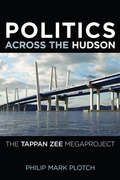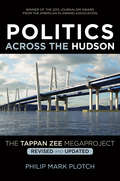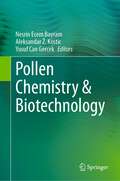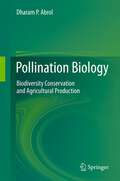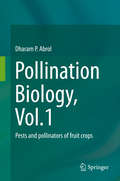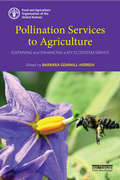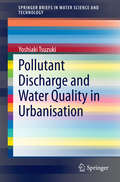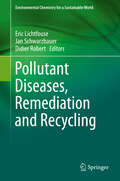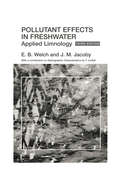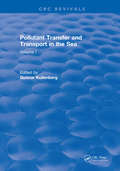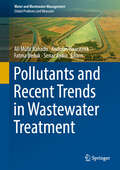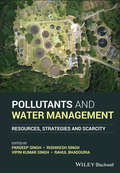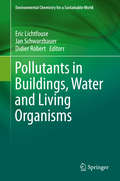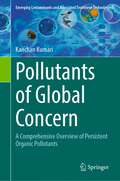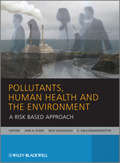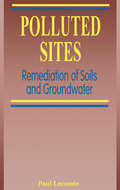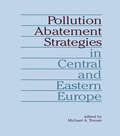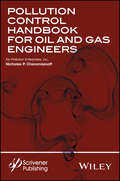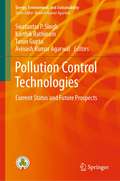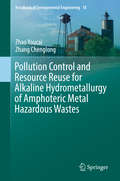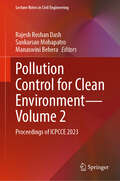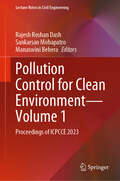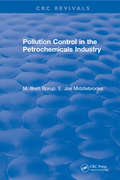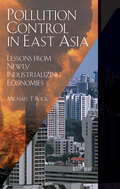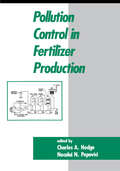- Table View
- List View
Politics Across the Hudson
by Philip Mark PlotchThe State of New York is now building one of the world's longest, widest, and most expensive bridges--the new Tappan Zee Bridge--stretching more than three miles across the Hudson River, approximately thirteen miles north of New York City. In Politics Across the Hudson, urban planner Philip Plotch offers a behind-the-scenes look at three decades of contentious planning and politics centered around this bridge. He reveals valuable lessons for those trying to tackle complex public policies while also confirming our worst fears about government dysfunction. Drawing on his extensive experience planning megaprojects, interviews with more than a hundred key figures--including governors, agency heads, engineers, civic advocates, and business leaders--and extraordinary access to internal government records, Plotch tells a compelling story of high-stakes battles between powerful players in the public, private, and civic sectors. He reveals how state officials abandoned viable options, squandered hundreds of millions of dollars, forfeited more than three billion dollars in federal funds, and missed out on important opportunities. Faced with the public's unrealistic expectations, no one could identify a practical solution to a vexing problem, a dilemma that led three governors to study various alternatives rather than disappoint key constituencies. Politics Across the Hudson continues where Robert Caro's The Power Broker left off and illuminates the power struggles involved in building New York's first major new bridge since the Robert Moses era. Plotch describes how one governor, Andrew Cuomo, shrewdly overcame the seemingly insurmountable obstacles of onerous environmental regulations, vehement community opposition, insufficient funding, interagency battles, and overly optimistic expectations.
Politics Across the Hudson: The Tappan Zee Megaproject (Rivergate Regionals Collection)
by Philip Mark PlotchWinner of the 2015 American Planning Association New York Metro Chapter Journalism Award The State of New York is now building one of the world’s longest, widest, and most expensive bridges—the new Tappan Zee Bridge—stretching more than three miles across the Hudson River, approximately thirteen miles north of New York City. In Politics Across the Hudson, urban planner Philip Plotch offers a behind-the-scenes look at three decades of contentious planning and politics centered around this bridge, recently renamed for Governor Mario M. Cuomo, the state's governor from 1983 to 1994. He reveals valuable lessons for those trying to tackle complex public policies while also confirming our worst fears about government dysfunction. Drawing on his extensive experience planning megaprojects, interviews with more than a hundred key figures—including governors, agency heads, engineers, civic advocates, and business leaders—and extraordinary access to internal government records, Plotch tells a compelling story of high-stakes battles between powerful players in the public, private, and civic sectors. He reveals how state officials abandoned viable options, squandered hundreds of millions of dollars, forfeited more than three billion dollars in federal funds, and missed out on important opportunities. Faced with the public’s unrealistic expectations, no one could identify a practical solution to a vexing problem, a dilemma that led three governors to study various alternatives rather than disappoint key constituencies. This revised and updated edition includes a new epilogue and more photographs, and continues where Robert Caro’s The Power Broker left off and illuminates the power struggles involved in building New York’s first major new bridge since the Robert Moses era. Plotch describes how one governor, Andrew Cuomo, shrewdly overcame the seemingly insurmountable obstacles of onerous environmental regulations, vehement community opposition, insufficient funding, interagency battles, and overly optimistic expectations...
Pollen Chemistry & Biotechnology
by Nesrin Ecem Bayram Aleksandar Ž. Kostic Yusuf Can GercekPollen is made up of many chemical constituents such as proteins, sugars, lipids, minerals and phytochemicals. These components make pollen products an excellent source of nutrients and antioxidants for consumers. However, mycotoxigenic fungi are also common in pollen, creating contamination from generated mycotoxins. With adequate monitoring, sampling, processing and storage of pollen the development of mycotoxins can be significantly prevented. Since pollen grain has strong membranes which can limit the bioavailability of some nutrients and phytochemicals, novel methods and pretreatments are required with special emphasis on microbiological pretreatment methodologies. Pollen Chemistry & Biotechnology summarizes current knowledge of the chemical composition of pollen, its importance as a functional food ingredient and its health promoting properties. As Introduction part a short elaborate about botanical characteristics and data, including morphology and anatomy of pollen and bee preferences, is given. Important factors such as the botanical and geographical origin, best practices for preservation of nutritional composition, bioactivity and safety of pollen are covered in full. The nutritional profile of pollen based on data for minerals, lipids and nutrients is presented. A detailed phytochemical profile of pollen based on data for phenolics, flavonoids, carotenoids, vitamins, bioactive compounds is also covered. Areas for the improvement of the bioavailability of different nutrients and bioactive compounds of pollen via applied pretreatments are presented, as are best practices for adequate pollen collection, procession and storage in order to obtain safe products. At the end, an overview about pollen bioactivity as reason to use it as source of pharmaceuticals is made.
Pollination Biology
by Dharam P. AbrolThis book has a wider approach not strictly focused on crop production compared to other books that are strictly oriented towards bees, but has a generalist approach to pollination biology. It also highlights relationships between introduced and wild pollinators and consequences of such introductions on communities of wild pollinating insects. The chapters on biochemical basis of plant-pollination interaction, pollination energetics, climate change and pollinators and pollinators as bioindicators of ecosystem functioning provide a base for future insights into pollination biology. The role of honeybees and wild bees on crop pollination, value of bee pollination, planned honeybee pollination, non-bee pollinators, safety of pollinators, pollination in cages, pollination for hybrid seed production, the problem of diseases, genetically modified plants and bees, the role of bees in improving food security and livelihoods, capacity building and awareness for pollinators are also discussed.
Pollination Biology, Vol.1
by Dharam P. AbrolThe book covers interplay between pest management strategies and safety of pollinators. Detailed information is provided on pests and pollinators of temperate, subtropical and tropical fruit crops. Most of the fruit crops are highly cross pollinated and depend upon insects or benefit from insect pollination for fruit set. Insect pests on the other hand cause major economic damage on fruit crops in tropics, subtropics and temperate. Evidently, pest management in fruit crops on one hand and providing safety to the pollinators on the other is a challenging task in the context of increasing horticultural productivity without upsetting the ecological balance. This book aims to integrate and develop pest control strategies in a way to minimize their impact on beneficial insect species such as natural enemies and pollinators to enhance fruit production and quality. The book covers interplay between pest management strategies and safety of pollinators. Detailed information is provided on pests and pollinators of temperate, subtropical and tropical fruit crops. Pollinators play a crucial role in flowering plant reproduction and in the production of most fruits and vegetables. Most of the fruit crops are highly cross pollinated and depend upon insects or benefit from insect pollination for fruit set. Insect pests on the other hand cause major economic damage on fruit crops in tropics, subtropics and temperate. Evidently, pest management in fruit crops on one hand and providing safety to the pollinators on the other is a challenging task in the context of increasing horticultural productivity without upsetting the ecological balance. This book aims to integrate and develop pest control strategies in a way to minimize their impact on beneficial insect species such as natural enemies and pollinators to enhance fruit production and quality. Most of the fruit crops are highly cross pollinated and depend upon insects or benefit from insect pollination for fruit set. Insect pests on the other hand cause major economic damage on fruit crops in tropics, subtropics and temperate. Evidently, pest management in fruit crops on one hand and providing safety to the pollinators on the other is a challenging task in the context of increasing horticultural productivity without upsetting the ecological balance. This book aims to integrate and develop pest control strategies in a way to minimize their impact on beneficial insect species such as natural enemies and pollinators to enhance fruit production and quality. The book covers interplay between pest management strategies and safety of pollinators.
Pollination Services to Agriculture: Sustaining and enhancing a key ecosystem service
by Barbara Gemmill-HerrenIt is only recently that the immense economic value of pollination to agriculture has been appreciated. At the same time, the alarming collapse in populations of bees and other pollinators has highlighted the urgency of addressing this issue. This book focuses on the specific measures and practices that the emerging science of pollination ecology is identifying to conserve and promote animal pollinators in agroecosystems. It reviews the expanding knowledge base on pollination services, providing evidence to document the status, trends and importance of pollinators to sustainable agricultural production. It provides practical and specific measures that land managers can undertake to ensure that agroecosystems are supportive and friendly to pollinators. It draws on the Global Pollination Project, supported by UNEP/GEF and implemented by FAO and seven partner countries (Brazil, Ghana, India, Kenya, Nepal, Pakistan and South Africa), which serve to provide "lessons from the field".
Pollutant Discharge and Water Quality in Urbanisation
by Yoshiaki TsuzukiThe main purpose of water quality monitoring may be seen as evaluating water quality conformity against water quality standards, especially for administrative purposes. Moreover, water quality monitoring data can be applied to estimate and evaluate pollutant loads in rivers. Chronological water quality fluctuations and vertical water quality profiles in water bodies are also important when taking into account the effects of land-based pollutants on coastal sea and estuary water quality. This book discusses the relationships between pollutant discharge and water quality, taking into account urban development and indicators like the pollutant load per capita flowing into the water body (PLCwb), an index used to evaluate the contribution of municipal wastewater pollutant discharge to pollutant loads flowing into ambient water bodies such as coastal zones, bays and lakes.
Pollutant Diseases, Remediation and Recycling
by Eric Lichtfouse Jan Schwarzbauer Didier RobertPollution has no borders. This popular 70's saying from early ecologists is surprisingly still true nowadays despite overwhelming scientific evidence and public awareness of the occurrence of artificial toxic substances in water, food, air, living organisms and the environment. This book presents advanced reviews on pollutant occurrence, transfer, toxicity and remediation. The chapter on school air quality by Dambruoso et al. highlights the overlooked health issue of airborne pollutants in buildings. Children are particularly threatened because they spend 90% of their time indoors, even in summer. The chapter on industrial wastewater pollutants by Dsikowitzky and Schwarzbauer reviews pollutants from textile, petrochemical, paper, tire, chemical and pharmaceutical plants. The authors describe advanced analytical methods and ecotoxicity tests. Industrial pollutants include dioxins and furans that are also reviewed in the chapter by Mudhoo et al. The chapter on fly ash by Gianoncelli et al. presents many techniques to treat fly ash and, in turn, decrease pollutant concentrations. The authors also explain that fly ash can be recycled in agriculture, buildings and geopolymers. The chapter on antifouling paints used for ship protection, by Sousa et al. , highlights the occurrence of toxic organotins in human organs such as heart, liver and breast milk. The chapter on surfactants by Rebello et al. focuses on safety concerns for humans and the ecosystems. Remediation techniques and green surfactants are presented. The chapters on toxic metals by Nava-Ruíz and Méndez-Armenta, Abarikwu and RistiÄ++ et al. describe sources, monitoring and diseases induced by lead, mercury, cadmium and thallium. The chapter on carcinogenic nitrosamines by Li et al. presents techniques and materials such as zeolites to remediate liquids and smoke containing nitrosamines.
Pollutant Effects in Freshwater: Applied Limnology
by J. Jacoby E. WelchPollutant Effects in Freshwater provides a practical and concise introduction to the ecological consequences of water pollution in aquatic ecosystems. In tackling the problem of water quality deterioration, this book combines the limnological and water pollution literature to describe how pollutants in wastewater affect populations of organisms in freshwater environments.Substantially revised, updated and expanded, with additional specialist contributors, this retitled new edition of Ecological Effects of Wastewater will continue to focus on the effects and management of eutrophication, water quality standards to protect aquatic life, and widen the debate over micro organisms and their public health significance in the aquatic environment.With ever tighter controls on pollution levels of freshwater bodies being implemented and enforced world wide, this book is essential reading for students of public health and environmental engineering, and a reference tool for professionals in consultancies, contractors and for those in regulatory and enforcement bodies.
Pollutant Transfer and Transport in The Sea: Volume I
by Gunnar KullenbergThis book covers those subject areas considered essential for the transfer and transport of pollutants in the marine environment. This publication will stimulate discussions and interdisciplinary research relevent to pollution problems as well as serve as an educational reference book.
Pollutants and Recent Trends in Wastewater Treatment (Water and Wastewater Management)
by Andreas Haarstrick Ali Müfit Bahadir Fatma Beduk Senar AydinThis book demonstrates the variability and extension of environmental pollutants in water and wastewater, besides with recent technological developments in wastewater treatment. It covers review articles and research studies written in a clear style that makes it informative for scientists, researchers, professionals, and students. This book provides a comprehensive overview of the current state of knowledge regarding source, transport and fate of not only emerging compounds, but also pollutants gaining importance over time, such as pharmaceuticals, microplastics, and viruses. It ensures to understand the dimension of the adverse effects on ecosystem and human health through various exposure pathway. The book also covers recent trends in wastewater treatment, with a focus on membrane technologies allowing to remove even very small concentrations of pollutants.
Pollutants and Water Management: Resources, Strategies and Scarcity
by Pardeep Singh Rishikesh Singh Rahul Bhadouria Vipin Kumar SinghPOLLUTANTS AND WATER MANAGEMENT Pollutants and Water Management: Resources, Strategies and Scarcity delivers a balanced and comprehensive look at recent trends in the management of polluted water resources. Covering the latest practical and theoretical aspects of polluted water management, the distinguished academics and authors emphasize indigenous practices of water resource management, the scarcity of clean water, and the future of the water system in the context of an increasing urbanization and globalization. The book details the management of contaminated water sites, including heavy metal contaminations in surface and subsurface water sources. It details a variety of industrial activities that typically pollute water, such as those involving crude oils and dyes. In its discussion of recent trends in abatement strategies, Pollutants and Water Management includes an exploration of the application of microorganisms, like bacteria, actinomycetes, fungi, and cyanobacteria, for the management of environmental contaminants.Readers will also discover a wide variety of other topics on the conservation of water sources including: The role of government and the public in the management of water resource pollutionThe causes of river system pollution and potential future scenarios in the abatement of river pollution Microbial degradation of organic pollutants in various water bodies The advancement in membrane technology used in water treatment processes Lead contamination in groundwater and recent trends in abatement strategies for it Highly polluting industries and their effects on surrounding water resources Perfect for graduate and postgraduate students and researchers whose focus is on recent trends in abatement strategies for pollutants and the application of microorganisms for the management of environmental contaminants, Pollutants and Water Management: Resources, Strategies and Scarcity also has a place in the libraries of environmentalists whose work involves the management and conservation of polluted sites.
Pollutants in Buildings, Water and Living Organisms
by Eric Lichtfouse Jan Schwarzbauer Didier RobertThis book presents advanced methods to analyse and clean pollutants, such as nanotechnology to treat water, techniques to remediate building materials, and bioindicators. It is very important that the understanding of these methods are brought to the attention of scientists, as cities and ecosystems are still polluted by toxic compounds despite efforts to clean the planet.
Pollutants of Global Concern: A Comprehensive Overview of Persistent Organic Pollutants (Emerging Contaminants and Associated Treatment Technologies)
by Kanchan KumariThis book is a compilation of all the necessary attributes associated with the knowledge of Persistent Organic Pollutants (POPs) that have been meticulously identified and charted down by the Stockholm Convention. Essential details starting from technical characteristics of the POPs to their expanse of nationwide usage, their remedial procedures adopted in India in comparison to available international data, and their consequent effects on biota and future perspectives are summarized with precision. Additionally, in-house scientific works that have been performed on each chemical are presented. Moreover, a unique feature of this book is that each chapter is dedicated to focusing on a single POP so that all the aspects of its usage, effects and fate can be accurately laid out. The book aims to be a go-to guidebook for stakeholders and academicians dealing with these chemicals who wish to be more acquainted with the present scenario of POPs and their status.
Pollutants, Human Health and the Environment
by Nick Voulvoulis K. Vala Ragnarsdottir Jane A. PlantPollutants, Human Health and the Environment is a comprehensive, up-to-date overview of environmental pollutants that are of current concern to human health.Clearly structured throughout, the main body of the book is divided by pollutant type with a chapter devoted to each group of pollutants. Each chapter follows a similar format to facilitate comparison and discussion. For each pollutant, the authors describe the sources, pathways, environmental fate and sinks as well as known toxicological effects. Importantly, the second chapter on heavy metals and other inorganic substances deals with trace element deficiencies which can have serious problems for human health. Some rocks and soils are naturally low in some trace elements and intensive agriculture over the past half century has effectively mined many trace elements reducing their levels in soils and crops. The final chapter is a discussion about the various risk assessment frameworks and regulations covering the main pollutants.Comprehensive, up-to-date coverage of environmental pollutants of concern to human health Clearly divided into pollutant type with each chapter devoted to a different pollutant group Clearly structured throughout with the same format for each chapter to help facilitate comparison and discussion and enable readers to prioritise chemicals of concern Description of the sources, pathways, environmental fate and known toxicological effect Includes contributions from leading researchers and edited by a team of experts in the field
Polluted Sites
by Paul LecomteThis is a translation of ""Les sites pollues: traitement des sols et des eaux souterraines"", second edition. It covers: contaminated sites; environmental diagnosis; assessment of hazard; remediaiton; costs; new legal requirements; and investments and role of insurance.
Pollution Abatement Strategies in Central and Eastern Europe
by Michael A. TomanProtecting environmental quality while pursuing economic development poses a particularly difficult challenge to the countries of Central and Eastern Europe, where political and economic systems are changing rapidly following decades of environmental neglect and economic mismanagement. Advanced industrial nations also face difficult decisions about priorities and procedures for providing financial assistance to the region. In order to identify workable solutions, Pollution Abatement Strategies in Central and Eastern Europe investigates some of the leading pollution problems that these countries now face and examines the link between economic restructuring and environmental improvement. Contributors to the volume assess the changes in the region's environmental conditions likely to result from economic restructuring and the benefits that might arise from improvements. They also consider the design of effective environmental policies for economies in transition, including the need to introduce or reform basic economic, legal, and regulatory constructs. Comparisons of incentive-based versus command-and-control environmental policies suggest that, despite the difficulties in implementing them, incentive-based policy options are worth pursuing in Central and Eastern Europe.
Pollution Control Handbook for Oil and Gas Engineering
by Nicholas P. CheremisinoffThis is a major new handbook that covers hundreds of subjects that cross numerous industry sectors; however, the handbook is heavily slanted to oil and gas environmental management, control and pollution prevention and energy efficient practices. Multi-media pollution technologies are covered : air, water, solid waste, energy. Students, technicians, practicing engineers, environmental engineers, environmental managers, chemical engineers, petroleum engineers, and environmental attorneys are all professionals who will benefit from this major new reference source. The handbook is organized in three parts. Part A provides an extensive compilation of abbreviations and concise glossary of pollution control and engineering terminology. More than 400 terms are defined. The section is intended to provide a simple look-up guide to confusing terminology used in the regulatory field, as well as industry jargon. Cross referencing between related definitions and acronyms are provided to assist the user. Part B provides physical properties and chemical safety information. This part is not intended to be exhaustive; however it does provide supplemental information that is useful to a number of the subject entries covered in the main body of the handbook. Part C is the Macropedia of Subjects. The part is organized as alphabetical subject entries for a wide range of pollution controls, technologies, pollution prevention practices and tools, computational methods for preparing emission estimates and emission inventories and much more. More than 100 articles have been prepared by the author, providing a concise overview of each subject, supplemented by sample calculation methods and examples where appropriate, and references. Subjects included are organized and presented in a macropedia format to assist a user in gaining an overview of the subject, guidance on performing certain calculations or estimates as in cases pertinent to preliminary sizing and selection of pollution controls or in preparing emissions inventories for reporting purposes, and recommended references materials and web sites for more in-depth information, data or computational tools. Each subject entry provides a working overview of the technology, practice, piece of equipment, regulation, or other relevant issue as it pertains to pollution control and management. Cross referencing between related subjects is included to assist the reader to gain as much of a practical level of knowledge.
Pollution Control Technologies: Current Status and Future Prospects (Energy, Environment, and Sustainability)
by Avinash Kumar Agarwal Tarun Gupta Swatantra P. Singh Karthik RathinamThis monograph is based on pollution control technologies available to deal with water and air pollution. It includes removal of variety of pollutants including arsenic, chromium, uranium, pesticides and arsenic from water using adsorption technique. In addition, this book deals with the sampling and removal of microplastics using various techniques. The contents also focus on the role of membrane technology in water and wastewater treatment, and particulate matter air pollution and its control techniques. This volume will be a useful guide for researchers, academics and scientists.^
Pollution Control and Resource Reuse for Alkaline Hydrometallurgy of Amphoteric Metal Hazardous Wastes
by Zhao Youcai Zhang ChenglongThis book provides a comprehensive description of alkaline hydrometallurgy of amphoteric metal hazardous wastes. Topics focus on leaching of zinc and lead hazardous wastes, purification of leach solution of zinc and lead, electrowinning of zinc and lead from purified alkaline solutions, chemical reactions taking place in the production flowsheets, thermodynamic and spent electrolyte regeneration, alkaline hydrometallurgy of low-grade smithsonite ores, recovery of molybdenum and tungsten using ion flotation and solvent extraction processes and their application in chemical synthesis of Nb and Ta inorganic compounds, and industrial scale production of 1500-2000 t/a zinc powder using alkaline leaching-electrowinning processes. Processes described are cost-effective, generate lesser secondary pollutants, and have been applied widely in China. Readers that will find the book appealing include solid waste engineers, environmental managers, technicians, recycling coordinators, government officials, undergraduates and graduate students, and researchers.
Pollution Control for Clean Environment — Volume 2: Proceedings of ICPCCE 2023 (Lecture Notes in Civil Engineering #416)
by Sankarsan Mohapatro Manaswini Behera Rajesh Roshan DashThis book presents select proceedings of the International Conference on Pollution Control for Clean Environment (ICPCCE-2023). It introduces readers to the recent emerging pollutants in air and water environments and in solid waste and sheds light on the newly developed control strategies. The book discusses various topics including the occurrence of emerging contaminants, micropollutants in water, wastewater and aquatic environments, occurrence pathways, surface and groundwater pollution, and risk and impact assessment of pollution. The chapters provide advanced information topics including effective monitoring, detection, sustainable practices, cleaner and innovative water and wastewater treatment technologies, and emerging contaminant removal. The book also includes information on energy-positive technologies and recent advances in the upgradation of existing systems. It also extensively discusses life cycle assessment and the application of environmental indicators and circular economy in pollution control strategies. The book covers the interaction of pollutants in the atmosphere and discusses innovative air pollution control strategies, including a detailed discussion of carbon capture and storage. The book presents various strategies for managing solid waste and discusses several novel technologies for the management of the present-day concern of plastic waste and e-waste. Given the present-day need for the recovery and re-use of various waste materials, this book delves extensively into how waste materials can be used for different purposes. It also talks about the recovery of energy and other useful by-products contributing towards economical and sustainable solutions. The book discusses various case studies on recently developed technologies and evaluates a wide range of technologies for pollutant removal and their implementation in the field. This book provides a ready reference for environmental engineers, practitioners, policymakers, and planners. It also served as a practical guide for industrial engineers, government bodies, ecologists, and researchers.
Pollution Control for Clean Environment—Volume 1: Proceedings of ICPCCE 2023 (Lecture Notes in Civil Engineering #415)
by Sankarsan Mohapatro Manaswini Behera Rajesh Roshan DashThis book presents select proceedings of the International Conference on Pollution Control for Clean Environment (ICPCCE-2023). It introduces readers to the recent emerging pollutants in air and water environments and in solid waste and sheds light on the newly developed control strategies. The book discusses various topics including the occurrence of emerging contaminants, micropollutants in water, wastewater and aquatic environments, occurrence pathways, surface and groundwater pollution and risk and impact assessment of pollution. The chapters provide advanced information topics including effective monitoring, detection, sustainable practices, cleaner and innovative water and wastewater treatment technologies, and emerging contaminant removal. The book also includes information on energy-positive technologies and recent advances in the upgradation of existing systems. It also extensively discusses life cycle assessment and the application of environmental indicators and circulareconomy in pollution control strategies. The book covers the interaction of pollutants in the atmosphere and discusses innovative air pollution control strategies, including a detailed discussion of carbon capture and storage. The book presents various strategies for managing solid waste and discusses several novel technologies for the management of the present-day concern of plastic waste and e-waste. Given the present-day need for the recovery and re-use of various waste materials, this book delves extensively into how waste materials can be used for different purposes. It also talks about the recovery of energy and other useful by-products contributing towards economical and sustainable solutions. The book discusses various case studies on recently developed technologies and evaluates a wide range of technologies for pollutant removal and their implementation in the field.This book provides a ready reference for environmental engineers, practitioners, policymakers and planners. It also served as a practical guide for industrial engineers, government bodies, ecologists and researchers.
Pollution Control for the Petrochemicals Industry
by M.Brett BorupThe petrochemicals industry is very complex and requires considerable knowledge of the individual processes to develop effective pollution control plans and processes. Information in this small book is intended to provide a base from which one can build. It is not exhaustive in describing the segments of the industry or pollution control techniques; however, it does provide a basic knowledge that should lead to intelligent, environmentally sound solutions to pollution prevention, control, and treatment.
Pollution Control in East Asia: Lessons from Newly Industrializing Economies (Environmental Development Ser. #No. 9)
by Michael T. RockWhy do some economies seem to excel at effective pollution management while others miss the mark when responding to deteriorating urban environments? These studies of pollution management in East Asia's newly industrialized economies (NIEs) include successful government responses in Singapore and Taiwan, qualified results in China and Indonesia, and much more limited success in Thailand and Malaysia. In each example, Michael Rock considers the starting point of the economy as it began its path toward industrialization in the post World War II period. He discusses the relevant historical and political context, the pressures placed on the political system from domestic and international sources, and the influence of ongoing trends in East Asia for democratization and economic liberalization. Rock's text makes it clear that each economy found unique, innovative ways to link environmental protection to its own political and economic institutions. Thus, while public pressure from both home and abroad gave strong impetus to successful programs in Taiwan, the development of policy in Singapore involved limited public review and a centralized, government-led process. The result of Rock's scholarship is a book that provides important lessons without being reductionist. The book offers insights to apply to pollution management in a diverse range of developing nations, but avoids attempts for precise prescriptions, or universally appealing, normative answers. A copublication of Resources for the Future and the Institute of Southeast Asian Studies (ISEAS).
Pollution Control in Fertilizer Production (Environmental Science & Pollution)
by C.A. Hodge"This timesaving guide addresses nearly every aspect of pollution control for the mining, production, transportation, and distribution of chemical fertilizers covering current and emerging technologies for all segments of the industry, including raw materials production, end products, and by-products."
